

DRAWDIO - draw music with a pencil, or a kitchen sink, or a banana, or... What is Drawdio?
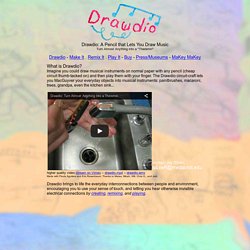
Imagine you could draw musical instruments on normal paper with any pencil (cheap circuit thumb-tacked on) and then play them with your finger. The Drawdio circuit-craft lets you MacGuyver your everyday objects into musical instruments: paintbrushes, macaroni, trees, grandpa, even the kitchen sink... higher quality video:Stream on Vimeo -- drawdio.mp4 -- drawdio.wmvMade with Paula Aguilera and Eric Rosenbaum. Thanks to Matea, Micah, Will, Chris G., and Jodi. Drawdio brings to life the everyday interconnections between people and environment, encouraging you to use your sense of touch, and letting you hear otherwise invisible electrical connections by creating, remixing, and playing. How Can I Participate? How Was It Invented? I like showing how ideas germinate. Drawdio - Make It . Mc10 - Conformal Electronics. Sketching Electronics. Distance Lab. Fashionable Technology Research Consortium.
Piezoelectric Nanowires Turn Fabric Into Power Source. Wouldn’t it be great if you could rock Kanye West’s outfit from the Grammys, but without the bulky battery pack?
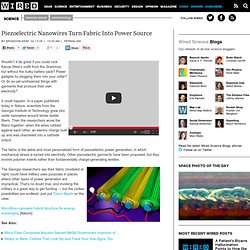
Power gadgets by plugging them into your collar? Or do as-yet-undreamed things with garments that produce their own electricity? It could happen. In a paper published today in Nature, scientists from the Georgia Institute of Technology grew zinc oxide nanowires around kevlar textile fibers. Then the researchers wove the fibers together; when the wires rubbed against each other, an electric charge built up and was channeled into a cathode output.
The fabric is the latest and most personalized form of piezoelectric power generation, in which mechanical stress is turned into electricity. The Georgia researchers say their fabric (modeled at right) could have military uses purposes in places where other types of power generation are impractical. Microfibre–nanowire hybrid structure for energy scavenging [Nature] See Also: Science Journalism 2.0: Pop the hood on Wired Science…. ETH - IfE-Wearable Computing - Textile Pressure Sensor. Media Electronics Lab More »» Job Links Open Position »» Latest News December 5, 2013Best Paper Award to Zack Zhu ACM 12th International Conference on Mobile and Ubiquitous Multimedia (MUM 2013) in Lulea, Sweden.

Achievements Single sensors and arrays of 16, 30 and 240 elements has been tested. Publications Textile Pressure Sensor for Muscle Activity and Motion DetectionJ. KOBAKANT. GraphExeter: New 1 atom thick. (Phys.org) -- The most transparent, lightweight and flexible material ever for conducting electricity has been invented by a team from the University of Exeter.
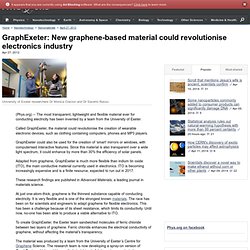
Called GraphExeter, the material could revolutionise the creation of wearable electronic devices, such as clothing containing computers, phones and MP3 players. GraphExeter could also be used for the creation of ‘smart’ mirrors or windows, with computerised interactive features. Since this material is also transparent over a wide light spectrum, it could enhance by more than 30% the efficiency of solar panels. Adapted from graphene, GraphExeter is much more flexible than indium tin oxide (ITO), the main conductive material currently used in electronics.
ITO is becoming increasingly expensive and is a finite resource, expected to run out in 2017. These research findings are published in Advanced Materials, a leading journal in materials science. Explore further: New light on novel additive manufacturing approach. Memristor memory could be used in wearable electronics. Researchers in South Korea are the first to make a bendable digital memory that can store data without constant power.
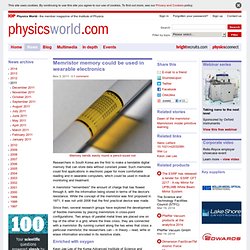
Such memories could find applications in electronic paper for more comfortable reading and in wearable computers, which could be used in medical monitoring and treatment. A memristor "remembers" the amount of charge that has flowed through it, with the information being stored in terms of the device's resistance. While the concept of the memristor was first proposed in 1971, it was not until 2008 that the first practical device was made. Since then, several research groups have explored the development of flexible memories by placing memristors in cross-point configurations. Two arrays of parallel metal lines are placed one on top of the other in a grid; where the lines cross, they are connected with a memristor. Enriched with oxygen. Reversibly stretchable transparent... [ACS Appl Mater Interfaces. 2012. Kit-of-No-Parts. I wish I had made one of these.
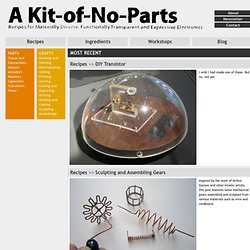
But no, not yet. Inspired by the work of Arthur Ganson and other kinetic artists, this post features some mechanical gears assembled and sculpted from various materials such as wire and cardboard. In contrast to casting traces by applying the cast material selectively to a flat surface, molded circuitry is cast into a mold. I’m interested in being able to cast both flexible and firm conductive materials in combination with common casting materials such as silicone and epoxy. This post describes various attempts at creating molds and […] Battery pouches made from paper, plastic and fabric are quick to make and are a cheap alternative to commercially available options. This coin-cell holder is made using copper tape and a mini cloths peg. This is one of the quickest techniques for prototyping circuits, as well as an efficient and reliable way of making flat and flexible circuitry.
Fountain pens can be used to draw with conductive paint.
KineticWorld.